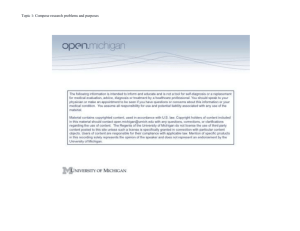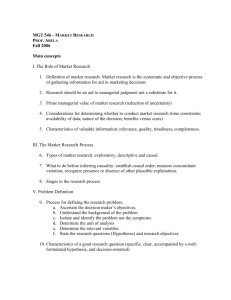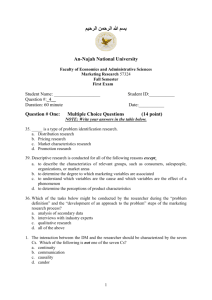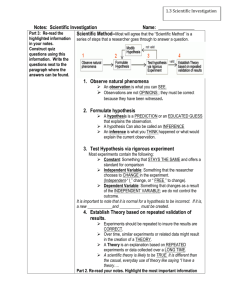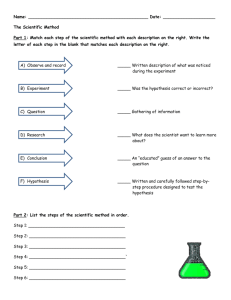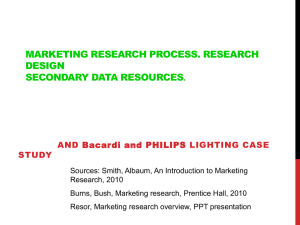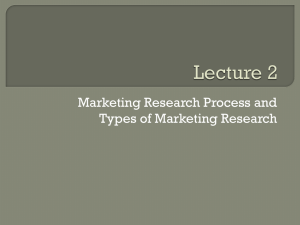Marketing Research
advertisement
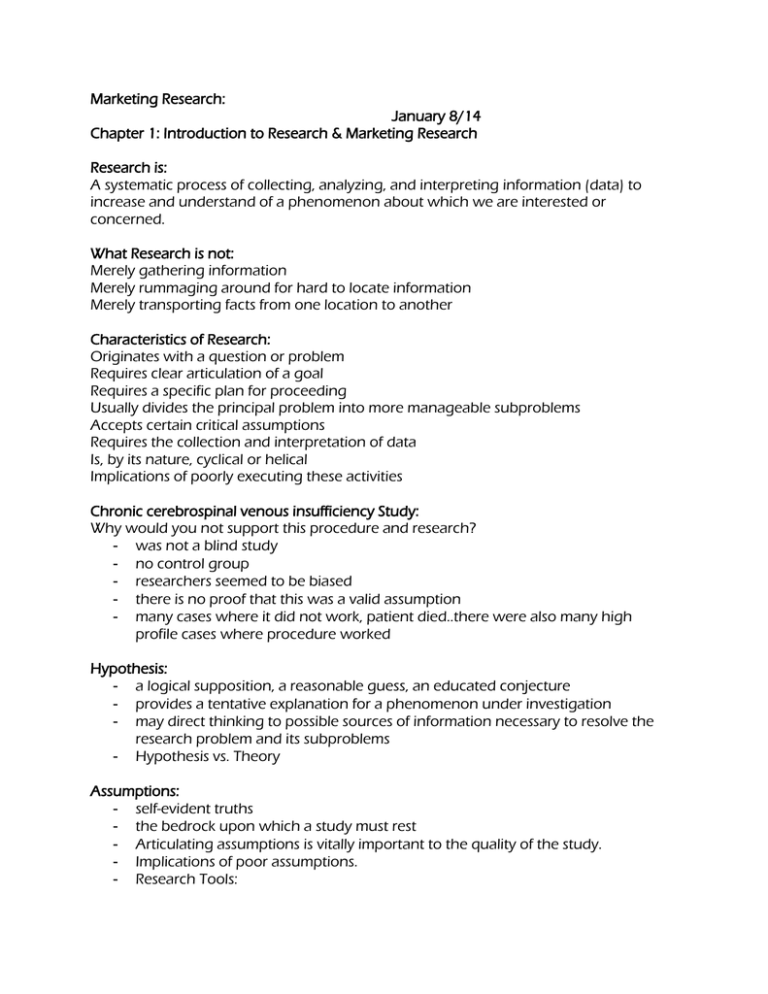
Marketing Research: January 8/14 Chapter 1: Introduction to Research & Marketing Research Research is: A systematic process of collecting, analyzing, and interpreting information (data) to increase and understand of a phenomenon about which we are interested or concerned. What Research is not: Merely gathering information Merely rummaging around for hard to locate information Merely transporting facts from one location to another Characteristics of Research: Originates with a question or problem Requires clear articulation of a goal Requires a specific plan for proceeding Usually divides the principal problem into more manageable subproblems Accepts certain critical assumptions Requires the collection and interpretation of data Is, by its nature, cyclical or helical Implications of poorly executing these activities Chronic cerebrospinal venous insufficiency Study: Why would you not support this procedure and research? - was not a blind study - no control group - researchers seemed to be biased - there is no proof that this was a valid assumption - many cases where it did not work, patient died..there were also many high profile cases where procedure worked Hypothesis: - a logical supposition, a reasonable guess, an educated conjecture - provides a tentative explanation for a phenomenon under investigation - may direct thinking to possible sources of information necessary to resolve the research problem and its subproblems - Hypothesis vs. Theory Assumptions: - self-evident truths - the bedrock upon which a study must rest - Articulating assumptions is vitally important to the quality of the study. - Implications of poor assumptions. - Research Tools: - specific mechanisms or strategies used to collect, manipulate, or interpret data. example survey Research Methodology: - the general approach the researcher takes in carrying out the research project. This approach dictates the particulate tools the researcher selects. Six tools of Research: - the library and its resources: - access to microforms, compact disks, online databases. - fast and efficient means of locating and access information on virtually any topic. - access to library holdings around the world Computer Technology as a research tool: - tools to calculate, compare, search, retrieve, sort, and organize data - software to analyze quantitative and qualitative data - storage of large amount of information - word processing - communication A theory is a well-established principle that has been developed to explain some aspect of the natural work. Measurement as a tool of Research: - Measurement: limiting the data of any phenomenon - substantial or insubstantial - so that those data may be interpreted and, ultimately, compared to a particular qualitative or quantitative standard. - Substantial measurements/manifest variables: those things being measured that have physical substance - Insubstantial measurements/latent variables: exist only as concepts, ideas, opinions, feelings, or other intangible entities - Reuires valed and reliable instruments - to measure physical characteristics - rulers, scales, speedometers, etc. - To measure the impact of social and psychological phenonmena - tests and questionnaires. Statistics as Tool of Research: - Main Functions of statistics: - Describe data - Draw inferences from the data Descriptive statistics summarize the general nature of the data obtained Inferential Statistics help the researcher make decisions about the data. Language as a Tool of Research: A tool to communicate and think more effectively Words have multiple meaning. Clarity is essential in research writing. Following guidelines for research writing is essential Using features if word processing makes revisions more efficient Words enhance thinking by: Reducing the world’s complexity Allowing abstraction of the environment Enhancing the power of thought facilitating generalization and inference drawing in new situations. The Human Mind as a Tool of Research: Critical Thinking: evaluating arguments in terms of their accuracy and worth May take a variety of forms: verbal reasoning argument analysis decision making critical analysis of prior research Deductive logic: begins with one or more premises - statements or assumptions that the researcher initially takes to be true Valuable for generating research hypotheses and testing theories. Inductive reasoning: Begins with an observation of a speific event to draw conclusions about entire classes of objects or events (i.e., observe and then draw conclusions about the population from which the sample has bee taken) The scientific method: the means whereby insight into the unknown is sought by: 1. identifying a problem that defines the goal of one’s quest 2. positioning a hypothesis that, if confirmed, resolves the problem; 3. gathering data relevant to the hypothesis 4. analyzing and interpreting the data to see whether they support the hypothesis theory building: is based on facts rather than naive beliefs and subjective impressions about the world involves thinking actively and intentionally about the phenomena at hand yields hypothesis to be tested usually involves collaboration with others. Marketing Research: What is Marketing? Marketing is the activity, set of institutions, and processes for creating, communicating, delivering, and exchanging offerings that have value for customers, clients, partners, and society at large. What is the Marketing Concept? The marketing concept is a business philosophy that holds that the key to achieving organizational goals consists of the company’s being more effective than competitors in creating, delivering, and communicating customer value to its chosen target markets. What is a Marketing Strategy? A marketing strategy consists of selecting a segment of the market as the company’s target market and designing the proper “mix” of the product/service, price, promotion, and distribution system to meet the wants and needs of the consumers within the target market. What is Marketing Research? Marketing Research is the process of designing, gathering, analyzing, and reporting information that may be used to solve a specific marketing problem. AMA Definition: Marketing Research: the function that links the consumer, customer, and public to the marketer through information; information used to identify and define marketing opportunities and problems generate, refine, and evaluate marketing actions monitor marketing performance and improve the understanding of marketing as a process. Marketing or Market Research: Marketing research: a process used by businesses to collect, analyze, and interpret information used to make sound business decisions and successfully manage the business. Market Research: a process used to define the size, location, and/or makeup of the market for a product or service. Marketing Research Function: Link the consumer to the marketer by providing information that can be used in making marketing decisions. Uses of Marketing Research: Identify marketing opportunities and problems Generate, refine, and evaluate potential marketing actions. Monitoring marketing performance Improve marketing as a process Identifying Marketing Opportunities and Problems: Some marketing research studies are designed to find out what consumers’ problems are and to assess the suitability of different proposed methods of resolving those problems. Generate, Refine and Evalutate Potential Marketing Actions: Selecting target marekts Product Research Pricing Research Promotion Research Distribution Research Monitor Marketing Performance: Tracking data collected at point-of-sale terminals as consumer packages goods are scanned in grocery stores, mass merchandisers, and conivence stores. tracking social media Improve Marketing as a Process: Basic research is conducted to expand out knowledge rather than to solve a specfic problem Applied research is conducted to solve specific problems Can We Determine If Something is Wrong? Most marketing research studies are trying to understand and predict consumer behavior, which is a difficult task, The Marketing Information System: A MIS is a structure consisting of people, equipment, and procedures to gather, sort, analyze, evaluate, and distribute needed, timely, and accurate information marketing decision makers. Components of an MIS: Internal Reports System Marketing Intelligence System Marketing Decision Support System Marketing Research System Marketing Research System It gathers information not gathered by the other MIS component subsystems Marketing research projects are not continuous; rather, they have a beginning and an end January 20th, 2014 Chapter 3: The Marketing Research Process and Defining the Problem and Research Objectives The Marketing Research Process Caveats to a Step-by-Step Process: Not always presented as an 11-step process Not all studies use all 11 steps You may be able to solve the problem with secondary data (a visit to the library or Google) Few studies follow the steps in order Step 1: Establish the Need for Marketing Research Is there a real need for marketing research? Research takes time and costs money Value of information versus cost of information? When is marketing research not needed? The information is already available The timing is wrong to conduct market research Funds are not available for marketing research Costs outweigh the value of marketing research Step 2: Define the Problem - Stating the Decision Alternatives This is the most important of 11 steps (assuming we’ve decided to do marketing research) If the problem is incorrectly defined, all else is wasted effort The need to make a decision requires decision alternatives. If there are no alternatives, no decision is necessary Step 3: Establish Objectives Research objectives, when achieved; provide the information necessary to solve the problem identified in step 2. Research objectives state what the researchers must do Step 4: Determine Research Design Descriptive research: a set of methods and procedures describing marketing variables. Diagnostics Research: designed to determine sources of satisfaction and dissatisfaction Prescriptive Research: provides information that allows the manager to best remedy the dissatisfaction Exploratory Research Design: collecting information in an unstructured and informal manner. Descriptive Research Design: research that describes the phenomena of interest Casual Research Design: attempt to uncover what factor or factors cause some event. Step 5: Identify Information Types and Sources: Primary Information: information collected specifically for the problem at hand Secondary Information: information already collected. ** finish steps** Video Case Questions: Of the brands featured in the case, whose demise may have been significantly slowed or prevented through better marketing research? Kodak: could have went ahead with digital cameras. There is not as strong of a demand for digital cameras, but there is still a market Pan Am: always a demand for flights...decreasing operational issues The Research Objective: Research objectives are specific and tell the researcher exactly what information must be collected to solve the problem by facilitating selection of an alternative. Specify from whom information is to be gathered Specify what information is needed Specify the unit of measurement used to gather information Word questions used to gather information using the respondents’ frame of reference The Importance of Properly Defining the Problem: When you define a problem incorrectly, there is nothing you can do in the research process to overcome this error. This makes defining the problem and research objectives the most important step in the marketing research process. Chapter 4: Research Design Research design is a set of advance decisions that make up the master plan specifying the methods and procedures for collecting and analyzing the needed information. Why is Research Design Important? Good research design is the “first rule of good research” Knowledge of the needed research design allows advance planning so that the project may be conducted in less time and typically at a cost savings due to efficiencies gained in preplanning Objectives of Research Design To gain background information and to develop hypotheses To measure the state of a variable of interest To test hypotheses that specify the relationships between two or more variables Research Design: A Caution In many cases, research is an iterative process By conducting one research project, we learn that we may need additional research, which may result in using multiple research designs Three Types of Research Designs: Exploratory Descriptive Casual Exploratory Research: Exploratory research is usually conducted at the outset of research projects It is usually conducted when the researcher does not know much about the problems Uses of Exploratory Research: Gain background information Define terms Clarify problems and hypothesis Establish research priorities Exploratory Research Methods: Secondary data analysis: the process of searching for interpreting existing information relevant to the research topic Experience surveys: refer to gathering information from those to be knowledgeable on the issues relevant to the research problem Key-informant technique: gathering information from those thought to be knowledgeable in the issues relevant to the problem. Lead-user survey: used to acquire information from lead users of a new technology Case analysis: a review of available information about a former situation(s) that has some similarities to the current research problem Focus groups: small groups brought together and guided by moderator through an unstructured spontaneous discussion for the purpose of gaining information relevant to the research problem. Descriptive Research: Descriptive research is undertaken to describe answers to questions of ho, what, where, when and how. It is desirable when we wish to project a study’s findings to a larger population, if the study’s sample is representative. Descriptive Research Classifications: Cross-sectional studies measure units from a sample of the population at only one point in time Sample surveys are cross-sectional studies whose samples are drawn in such a way as to be representative of a specific population These studies are usually presented with a margin of error Longitudinal studies repeatedly measure the same sample units of a population over time. Since they involve multiple measurements over time, they are often described as “movies” of the population Continuous panels ask panel members the same questions on each panel measurement. Discontinuous panels vary questions from one panel measurement to the next. There are sometimes referred to as omnibus panels (omnibus meaning “including or coving many things or classes”) Discontinuous Panels: Discontinuous panels are demographically matched to some larger entity, implying representatives Discontinuous panels represent sources of information that may quickly accessed for a wide variety of purposes Continuous Panels: Brand-switching studies: studies examining how many consumers switched brands. Marketing-tracking studies: those that measure some variable(s) of interest - such as market share or unit sales - over time. Casual Research: Causality may be thought of as understanding a phenomenon in terms of conditional statements of the form “If x, then y”. Casual relationships are often determined by the use of experiments Experiments: An experiment is defined as manipulating an independent variable to see how it affects a dependent variable while also controlling the effects of additional extraneous variables. Independent Variable: Independent variables are those variables that the researcher has control over and wishes to manipulate the 4 P’s Examples are level of ad expenditure, type of ad appeal, display location, method of compensating salespersons, price, and type of product. Dependent Variables: Dependent variables are those variables that we have little or no direct control over but a strong interest in changing. January 29, 2014 Example from last class: Identify the individual, peer, faculty, and course factors that influence full-time 1st year undergraduate student drop-out rates at St.F.X. Explore how these factors differ based on undergraduate X degree programs, university faculty/school, and academic time period. Research Objectives: Unit of Measure - whore are you going to be studying? Constructs - What will you be studying? Can you capture them/it? Scope and delimiters - Geo graphic areas, groups of people, specific assessment of performance. Will the objectives help to address the problem? Case: (handed out in class) Identify three research objectives: Why are they good objectives? -Time periods: one semester, one academic year, over five years? February 3, 2014 Extraneous Variables: Extraneous variables are those variables that may have some effect on a dependent variable yet are not independent variables. Experimental Design: Experimental design is a procedure for devising an experimental setting such that a change in a dependent variable may be attributed solely to the change in an independent variable. Types of Experiments: Laboratory experiments are those in which the independent variable is manipulated and measures of the dependent variable are taken in a contrived, artificial setting for the purpose of controlling the many possible extraneous variables that may affect the dependent variable. Field experiments are those in which the independent variables are manipulated and the measurements of the dependent variable are made on test units in their natural setting. Test Marketing: Test marketing is the phrase commonly used to indicate an experiment, study, or test that is conducted in a field setting. To test sales potential for a new product or service To test variations in the marketing mix for a product or service Selecting Test-Market Cities: Three main criteria: 1. Representativeness 2. Degree of isolation 3. Ability to control distribution and promotion Pros and Cons of Test Marketing: Advantages: test marketing allows for the most accurate method of forecasting future sales, and it allows firms the opportunity to pretest marketing-mix variables Disadvantages: test markets do not yield infallible results Competitors may intentionally try to sabotage test markets Test markets bring about exposure of the product to the competition Test markets may create ethical problems

